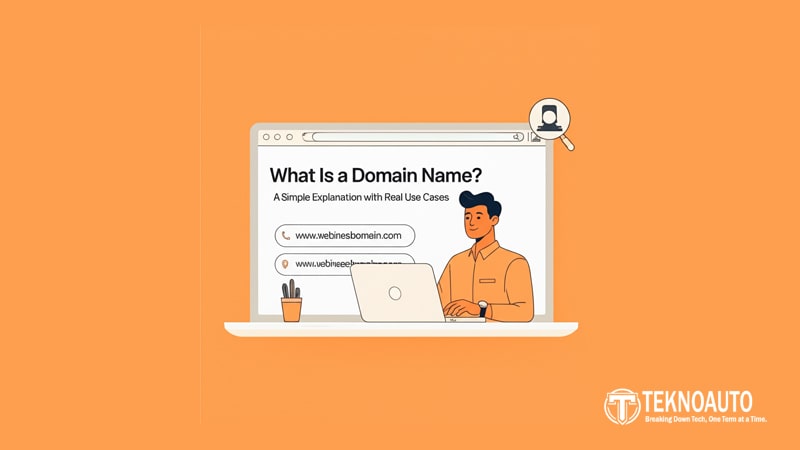In the vast expanse of the internet, navigating to specific locations can seem daunting. However, just like physical addresses guide you to homes and businesses, domain names serve as the online equivalent, directing you to websites and online resources.
What is a Domain Name?
A simple explanation boils down to this: it’s a human-readable address that replaces the complex numerical IP addresses computers use to identify each other.
The Foundation: Understanding IP Addresses
Before diving into domain names, it’s essential to understand IP addresses.
An IP (Internet Protocol) address is a unique numerical identifier assigned to every device connected to the internet. Think of it as your device’s “phone number.”
When you enter a website address into your browser, your computer uses the Domain Name System (DNS) to translate that human-readable address into a corresponding IP address—allowing it to connect to the correct server and retrieve the desired content.
Example IP address: 192.168.1.1
While machines process these numbers easily, humans struggle to memorize them. That’s where domain come in.
Domain Names: A User-Friendly Alternative
Domain names make it much easier to access websites without memorizing complex numbers. Instead, you can type something memorable, like google.com.
A domain name consists of two main parts:
- Second-Level Domain (SLD): The unique name, such as “google” or “amazon.”
- Top-Level Domain (TLD): The suffix, such as
.com,.org, or.net.
Together, these form a complete domain name (e.g., google.com), acting as a unique identifier for a website.
How Domain Names Work: The DNS System
The Domain Name System (DNS) translates human-friendly domain into machine-readable IP addresses. Here’s how the process works:
- You enter a domain name (e.g.,
example.com) into your browser. - The DNS resolver (usually provided by your ISP) receives the request.
- Root DNS servers are queried to find the correct TLD server.
- TLD DNS servers (e.g., for
.com) are contacted to find the authoritative DNS server. - Authoritative DNS server returns the correct IP address.
- The resolver delivers the IP address back to your browser.
- Connection is established, and the website loads.
This all happens within milliseconds.
Types of Top-Level Domains (TLDs)
TLDs sit at the highest level of the DNS hierarchy and are managed by IANA (Internet Assigned Numbers Authority). They include:
1. Generic TLDs (gTLDs)
.com– Commercial.org– Nonprofits.net– Originally for networks.info,.biz,.name– Informational, business, or personal use
2. Country Code TLDs (ccTLDs)
.us– United States.uk– United Kingdom.ca– Canada.de– Germany.jp– Japan
3. Sponsored TLDs (sTLDs)
.edu– Educational institutions.gov– Government.mil– U.S. military
4. Infrastructure TLD
.arpa– Technical infrastructure
Choosing the right TLD depends on your audience, location, and purpose.
Choosing the Right Domain Name: Best Practices
A strong domain enhances branding and discoverability. Here are key tips:
- Keep it short and memorable
- Use relevant keywords (without stuffing)
- Make it easy to spell and pronounce
- Avoid hyphens and numbers
- Choose the appropriate TLD
- Check availability
- Align with your brand
- Register variations to protect your brand
Registering a Domain Name: Step-by-Step
- Choose a domain registrar (e.g., GoDaddy, Namecheap)
- Search for availability
- Select your domain and TLD
- Choose a registration period (1–10 years)
- Add privacy protection (optional)
- Review and confirm your order
- Provide contact details
- Complete payment
- Verify your email
- Configure DNS settings
Real-World Use Cases of Domain Names
E-commerce
Domains like amazon.com and shopify.com are essential to online branding.
Blogs & Personal Sites
Personal sites like traveladventures.com help individuals share stories.
Businesses
Professional domains build trust (e.g., reliableaccounting.com).
Non-Profits
Organizations like saveourearth.org raise awareness and collect donations.
Education & Government
Institutions use .edu and .gov domains for credibility and trust.
Custom emails (e.g., info@yourdomain.com) add professionalism.
Portfolios & Creatives
Freelancers use domains like photographername.com for exposure.
URL Shorteners
Tools like Bit.ly convert long URLs to shareable short links.
Advanced Domain Name Concepts
Subdomains
E.g., blog.example.com – used for separate content areas.
Domain Parking
Domains held without a website—often for monetization or brand protection.
Domain Forwarding
Redirect traffic from one domain to another.
WHOIS Database
Contains registrant details. Privacy options are available.
DNSSEC
Security layer to protect against DNS spoofing and attacks.
Internationalized Domain Names (IDNs)
Support for non-Latin scripts (e.g., Arabic, Chinese).
New gTLDs
Extensions like .tech, .shop, .blog expand choices.
Troubleshooting Common Domain Name Issues
Domain Not Resolving
- DNS changes may take time to propagate.
- DNS records might be misconfigured.
- The domain may have expired.
Website Not Loading
- Web server issues or incorrect DNS settings.
- Firewall may be blocking access.
Email Problems
- Incorrect MX records or spam filters.
- Email server outages.
WHOIS Errors
- Update registrant info via your registrar.
Domain Hijacking
- Use strong passwords, enable two-factor authentication, and domain locking.
The Future of Domain Names
- More new gTLDs for personalization
- Blockchain-based domains for decentralized control
- Integration with AI, VR, IoT
- Stronger focus on brand protection
- Better user experiences from registrars and DNS providers
Conclusion: Domain Names – The Key to Your Online Identity
Understanding domain names goes far beyond knowing what a web address is. It’s about identity, accessibility, and professionalism online.
From choosing the right name to managing DNS settings, this guide has equipped you with the knowledge to take control of your digital presence. Whether you’re launching a blog, starting a business, or building a portfolio, your domain name is the foundation of your online success



